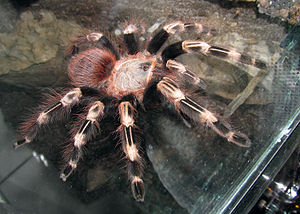Nhandu chromatus
| Nhandu chromatus | ||||||||||||
|---|---|---|---|---|---|---|---|---|---|---|---|---|

female |
||||||||||||
| Systematics | ||||||||||||
|
||||||||||||
| Scientific name | ||||||||||||
| Nhandu chromatus | ||||||||||||
| Schmidt , 2004 |
Nhandu chromatus is a species of Brazilian tarantula . Individual specimens were discovered in the Brazilian state of Piauí . This species was described by Günter Schmidt in 2004. The species name comes from the ancient Greek word χρωμα (in German color ). It was so named because the spider is very noticeably colored. The spiders belong to the ground-dwelling species and dig their burrows into the ground. For their defense they have stinging hairs on their abdomen, which they can strip off in case of danger. The species is sometimes kept in terrariums and is relatively easy to breed. Offspring are therefore often offered in pet shops (specialist shops or stock exchanges).
Way of life and habitat
Not much is known about the distribution and how it lives in nature. In captivity, they sometimes show a strong digging and a strong spinning activity. They line their living tubes with spider silk. When they are disturbed, they often put their stinging hair on the opisthosoma. Mating in captivity is possible and the cocoons contain up to 700 eggs. The larvae are very small and develop slowly.
features
The females reach a length from the bite claws to the spinnerets of six centimeters. The males are usually smaller and reach a body length of four to five centimeters.
The animals have a basic black color. The tarsi have a narrow white horizontal stripe at the base in the transition to the metatarsi. At the transition from the metatarsus to the tibia, the spiders have a wide, white horizontal stripe that is present on both limbs. The tibia also have two white longitudinal stripes similar to Aphonopelma seemanni . Such longitudinal stiffeners are also found on the patella. The patella has a white horizontal stripe at the transition to the tibia. The femur, on the other hand, is colored uniformly black. From the metatarsus to the patella there are longer white to reddish hairs, which give the spider a very hairy appearance. Long black hairs are found on the femur. The bite claws are dark to black in color. The opisthosoma is black and has longer red hair. It looks very similar to that of Brachypelma vagans . There are stinging hairs on the opisthosoma. The tarantulas therefore belong to the so-called " bombardier spiders ". In the female, the carapace has pale gray hairs. In the male, the carapace is dark brown to black in color. The tibial apophyses of the male probes have a tightly fitting thorn-like spine. The animals do not have stridulation bristles .
They are similar in color to the species Acanthoscurria geniculata . That is why she was sometimes referred to as a " doppelganger " before she was first described. In contrast to N. chromatus, A. geniculata has a black carapace and has no red hair on the legs or on the opisthosoma. The species is also similar to the related species Nhandu coloratovillosus . However, this has a darker carapace and the longitudinal stripes on the tibia and patella are less pronounced. The chelicerae, on the other hand, are lighter in color than in the N. chromatus and have about the same color as the patella.
Systematic problem
Animals of this species were mistakenly confused with the species Lasiodora cristata (Mello-Leitão, 1923) in the pet trade . A female of this species was described as Acanthoscurria cristata in 1923 . It was then moved to the genus Pamphobeteus in 1964 . In 1998 the species was added to the genus Vitalius . In 2001 this species was finally assigned to the genus Lasiodora by the arachnologist Rogério Bertani . Although the animals in the terrariums and in the trade are actually Nhandu chromatus, this resulted in various incorrect species names: Acanthoscurria cristata , Pamphobeteus cristatus , Vitalius christatus and Lasiodora cristata .
This error was long maintained by arachnologists. A male of Nhandu chromatus was described by Marc Baumgarten in the arachnological indicator in 1998 as a male of Vitalius cristatus , although he was already making assumptions that it might be a new species. In 2004 the animals were finally described as Nhandu chromatus . The animals in trade and in private terrariums now belong to this species.
Web links
Nhandu chromatus in the World Spider Catalog
Individual evidence
- ↑ a b c d e Günter Schmidt: The double of Acanthoscurria geniculata (CL KOCH, 1841) is called Nhandu chromatus sp. n. (Araneae: Theraphosidae: Theraphosinae) . In: Tarantulas of the world, April 29, 2004, pp. 6-10.
- ↑ Peter Klaas: tarantulas: origin, care, species . Eugen Ulmer Verlag , Stuttgart 2003/2007, ISBN 978-3-8001-4660-4 , pp. 109-110
